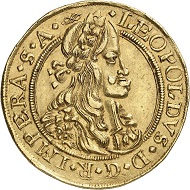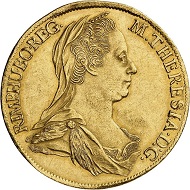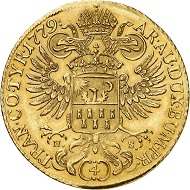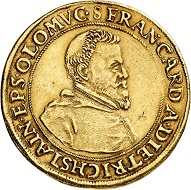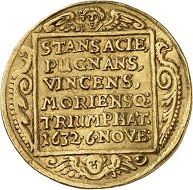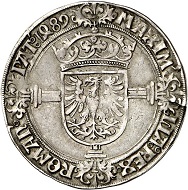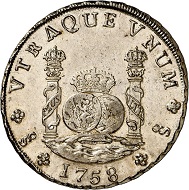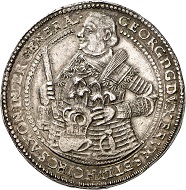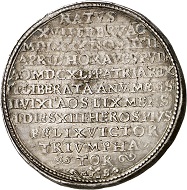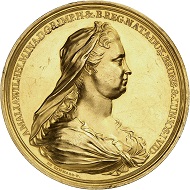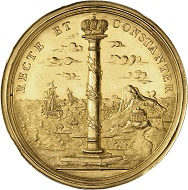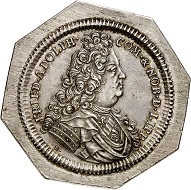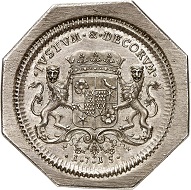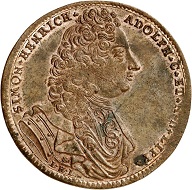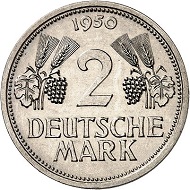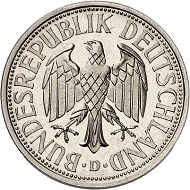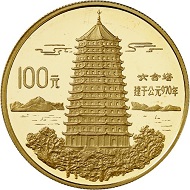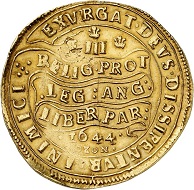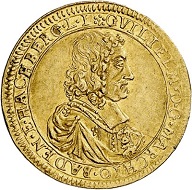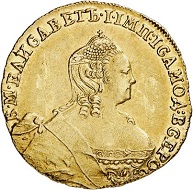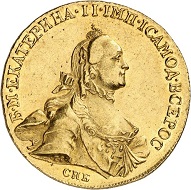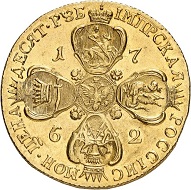17-06-2018 – 20-06-2018
Auctions 307-310
More than 2,000 bidders made Künker’s summer auctions a success
Several specialized collections allured more than 2,000 national and international bidders, who tried their luck at one of Künker’s four summer auctions. 300 of them were present in the auction hall and could witness numerous coins reach record hammer prices. Whether it was the rarities from the Spanish Netherlands from the Geneart collection, the outstanding talers of the House of Welf from the Popken collection, or the rare coins and medals of the Counts of Lippe – all of them were greeted by vigilant and enthusiastic collectors. Thus, it is not surprising that three out of the four top sellers were coins from the Habsburg Monarchy.
No. 6275. Holy Roman Empire. Leopold I, 1657-1705. 5 ducats 1691, Prague. Very rare. Very fine+. Estimate: 10,000 euros. Price realized: 100,000 euros.
Along with a 5 ducats piece by order of Leopold I, minted in Prague in 1691, which rose from 10,000 to 100,000 euros, three other pieces were realized at 65,000 euros:
No. 6292. Holy Roman Empire. Maria Theresa, 1740-1780. 4 ducats 1779, Alba Iulia. Extremely rare. Nearly extremely fine. Estimate: 50,000 euros. Price realized: 65,000 euros.
A 4 ducats by Maria Theresa, minted in Alba Iulia in 1779 (Estimate: 50,000 euros),
No. 6400. Olomouc. Franz von Dietrichstein, 1599-1624-1636. 5 ducats n.d. (approx. 1630), Kromeríz. Extremely rare. Very fine+. Estimate: 20,000 euros. Price realized: 65,000 euros.
a 5 ducats by Franz von Dietrichstein as Bishop of Olomouc (Estimate: 20,000 euros),
No. 6637. Nuremberg. 3 ducats 1632 on the occasion of the passing of Gustav II Adolf. Extremely rare, probably the only specimen on the market. Estimate: 15,000 euros. Price realized: 65,000 euros.
and a 3 ducats by the town of Nuremberg on the occasion of the death of Gustav II Adolf, minted in 1632 (Estimate: 15,000 euros).
No. 174: Brabant. Philip the Handsome, 1482-1506. Fifth emission, 1489-1492. Quadruple patard 1489, Antwerp, featuring the title of Maximilian I. Very rare. Very fine. Estimate: 3,000 euros. Price realized: 15,000 euros.
Auction 307: The Genaert collection – Coins from the Spanish Netherlands / Foreign coins and medals
But let us begin with the auction week’s first day: the Geneart collection, which is a unique set of all of the coins that were once used as a form of payment in the Spanish Netherlands, was auctioned off first. People from many countries were interested in this collection, especially because the Spanish Netherlands once encompassed a territory which makes up five different nations nowadays: the Benelux countries, France, and Germany.
Whether it was an interesting coin or medal from the Middle Ages or an outstanding portrait of the Renaissance or Baroque era, as always, beautiful engraving and a perfect grade were very popular. One fitting example is the Quadruple parard of Philip the Handsome, minted featuring the title of his father Maximilian I in Antwerp for Brabant in 1489. The bids rose from 3,000 to 15,000 euros.
No. 1186. Poland. Sigismund III, 1587-1632. Reichstaler 1627, Bromberg. Very rare. Very fine. Estimate: 35,000 euros. Price realized: 44,000 euros.
A 1/2 Ecu by Philipp II of Spain depicts an outstanding portrait as Count of Flanders. Only a few specimens remain of this piece that was minted in Ghent in 1581. A collector thought it worth 24,000 euros (Estimate: 3,000 euros).
In general, collectors know exactly how rare a piece is and thus they occasionally accept a somewhat poorer grade. Apart from some well-informed bidders, nobody could have expected that a plain pfennig by the Abbey of Echternach would rise from 500 to 8,000 euros. It is attributed to Abbot Gerard I, who administered the Abbey immediate to the empire and under whose reign the church burned down.
No. 1186. Poland. Sigismund III, 1587-1632. Reichstaler 1627, Bromberg. Very rare. Very fine. Estimate: 35,000 euros. Price realized: 44,000 euros.
Foreign coins and medals that were auctioned off after the Genaert collection were also realized at impressive prices. A very rare reichstaler of King Sigismund III, minted in Bromberg in 1627, is representative of those pieces. Its very simple design makes it seem quite monumental and thus its price was realized at 44,000 euros (Estimate: 35,000 euros).
No. 1272: Chile. Fernando VI, 1746-1760. 8 reales 1758, Santiago. Extremely rare. Outstandingly well-struck specimen. Very fine to extremely fine. Estimate: 25,000 euros. Price realized: 32,000 euros.
A reales de a ocho minted in Chile in 1758 und Ferdinando VI was sold at 32,000 euros. Its exceptionally well-preserved coinage caused the price of this rarity to rise from 25,000 to 32,000 euros.
The silver coins of the Holy Roman Empire are almost overshadowed by their golden counterparts. Judging from their results, they surely do not have to duck out of sight. An almost extremely fine guldiner from 1486, the famous “first taler”, was sold at 22,000 euros (estimate: 15,000 euros). A very rare, contemporary medal of Ferdinand I minted in 1534 changed hands at 15,000 euros (estimate: 5,000 euros).
No. 2306. Brunswick-Calenberg-Hanover. George, 1636-1641. Double reichstaler 1641, Zellerfeld, on his death. Extremely fine to FDC. Estimate: 20,000 euros. Price realized: 34,000 euros.
Auction 308: The Friedrich Popken collection – Coins and medals from the House of Welf / German coins and medals
The roundelay of collections was continued with auction 308 on June 19th: it contained another part of the Friedrich Popken collection, this time it was coins and medals from the House of Welf. The highest bid of the collection was on a double reichstaler minted on the occasion of the death of George, Duke of Brunswick-Lüneburg in 1641 (20,000 / 34,000 euros).
No. 2379. Brunswick-Calenberg-Hanover. Wilhelmine Amalie, daughter of Johann Friedrich, spouse of Emperor Joseph I. Gold medal in the weight of 50 ducats, no date (1713), of A. di Gennaro. Extremely rare. Extremely fine. Estimate: 25,000 euros. Price realized: 30,000 euros.
The second highest price was realized by a woman, namely Amalie Wilhelmine, daughter of Duke Johann Friedrich of Brunswick-Calenberg and wife of Emperor Joseph I. A gold medal minted in 1713 at the time of her widowhood was realized at 30,000 euros (estimate: 25,000 euros).
One of the most popular coins from the House of Welf is the reichstaler from 1702 on the break-up of the fraternal unity. The most interesting aspect of this coin is that the most modern technology of the time was used to convey a political message. In 1654, Otto of Guericke proved the physics of atmospheric pressure using the Magdeburg hemispheres. When the rims were sealed and the air was pumped out, the sphere could not be pulled apart. Once they were filled with air again, they could be separated. A perfect specimen of this so-called “Luftpumpentaler“ was part of the Popken collection at an estimate of 10,000 euros. Its new owner won the bid at 15,000 euros.
No. 4218. Lippe. Friedrich Adolf, 1697-1718. Octogonal klippe in the weight of 1 1/4 reichstaler 1715, Detmold. Very rare. Extremely fine. Estimate: 6,000 euros. Price realized: 15,000 euros.
Auction 309: The Gunther Wiegrebe collection: Coins and medals from the counts and princes of Lippe / German coins from 1871
For more than two generations, Gunther Wiegrebe and his father collected coins in order to assemble this collection of coins and medals from the counts and princes of Lippe. It contained a lot of rarities. They were met with an excited reception.
The most expensive lot of this collection was the octagonal 1 1/4 reichstalerklippe minted in Detmold in 1711, which was sold at 15,000 euros (estimate: 6,000 euros).
At 13,000 euros, the price of this very fine 2/3 taler dated 1683 was realized almost as high as the aforementioned reichstaler (estimate: 5,000 euros). That is indicative of how rare this coin is!
No. 4247. Lippe: Simon Heinrich Adolf, 1718-1734. Copper strike of the dies of the 2/3 taler 1722, Detmold. Very rare. Extremely fine. Estimate: 150 euros. Price realized: 1,550 euros.
This copper strike of the dies of the 2/3 taler from 1722 ended up being the most surprising item of this collection. The very rare piece of the Grönegreß collection rose tenfold from an estimate of 150 euros to a price realized at 1,550 euros.
In 1400, the Counts of Schaumburg mortgaged the County of Sternberg to the Counts of Lippe. Due to this connection, Gunther Wiegrebe included in his collection a pfennig of Heinrich I as Count of Sternberg. This specimen from the Dr. Bernard Schulte collection, which is the most beautiful and only one that is privately owned, was estimated at 3,000 euros but sold at 11,000 euros.
No. 5561. Germany. Essay of 2 DM 1950, D, rye stalks, cupro-nickel of Jäger 386. Estimate: 1,500 euros. Price realized: 9,500 euros.
Let us take a last look at the collection of essays of Germany, which was also offered in catalog 309. This unique ensemble contained extremely rare pieces, for example a 2 Deutsche Mark cupro-nickel coin with the issued date 1950 D, which was never realized. It changed hands at 9,500 euros.
This collection of 330 patterns, which would be worthy of any museum, was offered as lot 5566 at an estimate of 10,000 euros. It was sold at a total of 85,000 euros.
No. 6044. China. 100 yuan 1995. Only 1,000 specimens struck. Proof. Estimate: 7,500 euros. Price realized: 24,000 euros.
Auction 310: Chinese coins / Gold world coins / Russian coins and medals
Modern coins, too, can be sold at impressive prices. This was proven by a 100 Yuan piece, one of only 1,000 specimens struck, from 1995 that was sold at 24,000 euros. This coin was estimated at 7,500 euros and depicts the Six Harmonies Pagoda in Hangzhou on the reverse.
No. 6144. England. Charles I, 1625-1649. Triple unite 1644, Oxford. Very rare. Nearly extremely fine. Estimate: 50,000 euros. Price realized: 60,000 euros.
It came as no surprise that the most expensive lot of the world coins selection was the triple unite of Charles I, minted in Oxford in 1644. The very rare piece combines a decisive era of English history in its design. What is more, it is representative of the biggest gold emission that was ever coined in England. The price realized at 60,000 euros was to be expected (estimate: 50,000 euros).
No. 6425. Baden-Baden. Wilhelm, 1622-1677. Ducat 1674, Baden-Baden. Extremely rare. Extremely fine. Estimate: 30,000 euros. Price realized: 55,000 euros.
We already mentioned at the beginning how well the gold coins and medals from the Holy Roman Empire and its princes performed in this auction. Thus, we can refrain from going into more detail here. It is pleasing, though, that gold coins and medals from Germany were realized at high prices, too. Let us mention just three examples: firstly, the ducat of margrave William of Baden, minted in Baden-Baden in 1674 (30,000 / 55,000 euros).
Next, a gem of a 5 ducats piece of Maximilian I of Bavaria, which he had minted on the occasion of the new fortification of the town of Munich in 1640. This is not a very rare coin, but PCGS had graded this piece at MS64 (7,500 / 42,000 euros).
Last but not least, another gem: a ducat of Augustus The Strong, minted in Dresden in 1731 (17.500 / 38.000 euros).
No. 7014: Russia. Elisabeth, 1741-1761. 5 ruble 1758, Moscow, red mint. Very rare. Extremely fine +. Estimate: 12,500 euros. Price realized: 48,000.
A small but impressive selection of Russian coins and medals concluded Künker’s auction week in Osnabrück. Owing to their good grade, the hammer prices were much higher than the previous estimates. For example, the 1758 quintuoke ruble coin by tsarina Elisabeth from the red mint of Moscow was sold at 48,000 euros (estimate: 12,500 euros).
No. 7022. Russia. Catherine II, 1762-1796. 10 ruble 1762, St. Petersburg. Rare. Extremely fine to FDC. Estimate: 10,000 euros. Price realized: 40,000 euros
Compared to Elisabeth, Tsarina Catherine II fell a little short at 40,000 euros. Nevertheless, this was a remarkable hammer price for a 10 ruble minted in St. Petersburg in 1762 (estimate: 10,000 euros).
You can find all of the results of these auctions on Künker’s website.
The next auction will take place from October 8-12, 2018. Catalogs can be ordered at Künker, Nobbenburgerstr. 4a, 49 076 Osnabrück; Tel: 0541 / 96 20 20; Fax: 0541 / 96 20 222; or via e-mail.





